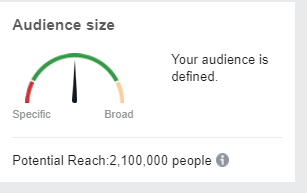How big should your audience be when running Facebook ads? Should you target narrow audiences that are smaller in size but match your ideal customer? Or should you go broad and target as many people as possible?

In this article I’ll explain how you should approach audience sizes when spending money on Facebook.
Bigger is better
The bigger your audience size is, the better chance your campaign has of being successful.
Typically, the minimum audience size I’ll use when reaching NEW audiences is one million users – minimum.
The counter argument to a broad approach is:
“But I’m selling a niche product and I don’t think one million people will buy my product. I think my audience size should be around 100,000 people.”
When I run ads with audience sizes of one million or more, I know many of them won’t be interested in my products or even click my ads, but that’s not why I target them.
The reason you should target large audiences when running ads is to give Facebook the best chance to get you the desired result.
Facebook is a machine learning algorithm and requires data to optimize your campaigns. If you provide them with an audience size of two million, it will shuffle through your audience and show your ads to users who are most likely to make your intended action.
Just because you choose an audience size of two million doesn’t mean Facebook will serve your campaign to two million people.
Run any campaign for over five days and check its Delivery Insights and you’ll find that your first-time impression ratio each day lowers well before you reach even half of your targeted audience.
 This is because Facebook ads are only served to users who are most likely to make your action. For example, if you have an audience size of two million and are optimizing for purchase conversions, and if Facebook thinks only 150,000 of them are likely to purchase based on your pixel data and their internal data, then it will aim to deliver your ads to the 150,000 people and ignore others who are unlikely to convert.
This is because Facebook ads are only served to users who are most likely to make your action. For example, if you have an audience size of two million and are optimizing for purchase conversions, and if Facebook thinks only 150,000 of them are likely to purchase based on your pixel data and their internal data, then it will aim to deliver your ads to the 150,000 people and ignore others who are unlikely to convert.
This is why you want big audiences, so Facebook can do its magic. An audience size of 100,000 means Facebook may have to serve your ads to users who aren’t that interested.
Bigger audiences are needed to scale
Most businesses dream of scaling up from $1k to $10k+ per day in ad spend.
To scale, you need big audiences. You cannot scale small audiences because you’ll reach everyone within a day or two.
When to use smaller audiences
For local businesses it can sometimes be impossible to target one million+ users when the entire population in your city is under that.
In these cases, I suggest using a carpet bomb approach which uses only basic filters such as age and no interest targeting.
See how your campaigns perform using this approach before you decide to add in lookalike audiences or interest targeting, which will reduce your audience size even more.
This is a common mistake I see local businesses make. They overuse the interest feature and reduce their audience size and potential reach.
How big are your audiences on Facebook?
These tips apply to ads that target new users. Retargeting audiences will often be much smaller in size, so don’t think that your website custom audiences need to be in the millions.
Facebook is a machine learning algorithm and provides the best ad results when it has data to work with. Just like a customer list of 10,000 emails will produce a better lookalike audience than a customer list of 1,000 users, bigger audiences provide Facebook with the best chance of ad optimization.
How big is your average audience size at the top of the funnel?